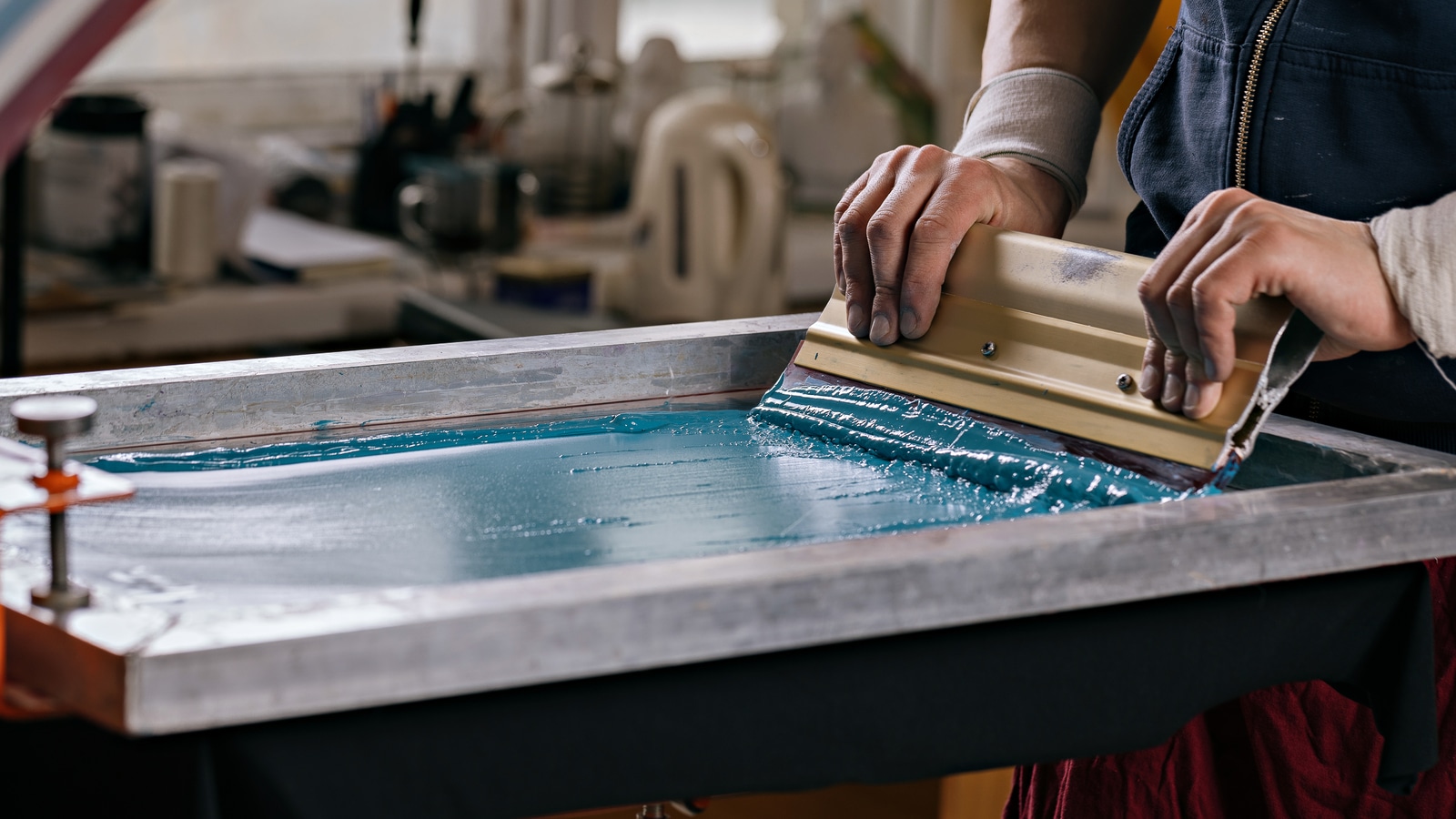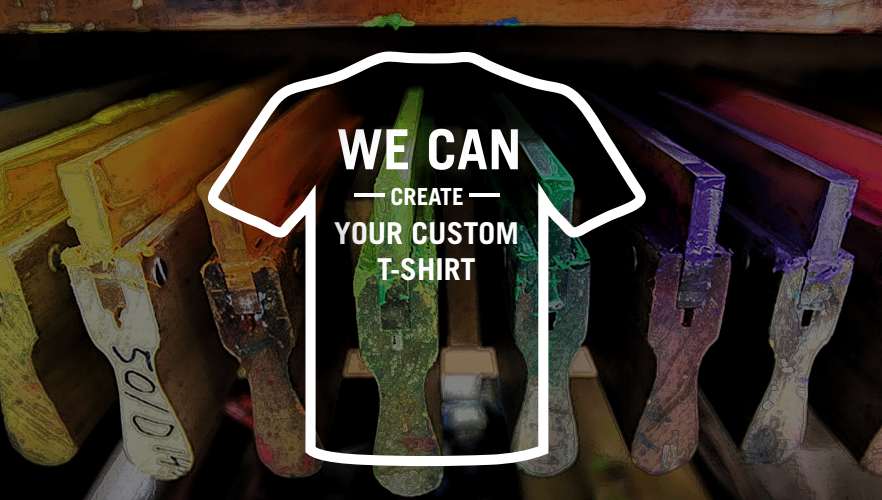Artistic Silk Screen Printing for Limited Edition Prints
Artistic Silk Screen Printing for Limited Edition Prints
Blog Article
Display Printing Uncovered: Whatever You Need to Find Out About Tee Shirt and Garment Printing Strategies
Screen printing is an interesting approach that integrates art with technique, offering unlimited opportunities for imagination. All set to check out the crucial aspects that make display publishing an art form?
The Essentials of Screen Printing: How It Functions
When you dive into display printing, you'll uncover it's both an art and a science. At its core, display printing includes producing a stencil, or display, that allows ink to pass through only in particular areas.
Placement the display over the fabric, after that use a squeegee to press ink via the display onto the garment. Each action is necessary, and understanding them will boost your display printing abilities, changing basic garments right into one-of-a-kind, expressive items.
Types of Screen Printing Techniques
As soon as you comprehend the essentials of display printing, it's time to check out the numerous techniques that can raise your designs. One preferred approach is traditional screen printing, where ink is pressed through a stenciled display.
If you're intending for fine details, consider discharge printing. This method eliminates color from the fabric, leaving a soft, classic look. An additional alternative is plastisol printing, understood for its toughness and dazzling shades, making it a favored for numerous brand names. Experiment with halftone printing to produce slope impacts and complex styles. Each technique has its distinct charm, so don't think twice to try them bent on discover what fits your design best!
Vital Equipment for Screen Printing
To attain spectacular results in screen printing, having the best devices is essential. You'll need a strong display printing framework, which holds the mesh that transfers your layout onto the garment. Next, invest in high-grade squeegees; these are important for applying ink equally across the screen.
Selecting the Right Inks and Materials
When picking inks and products for screen printing, you require to take into consideration the sort of ink that works best for your job. Consider textile compatibility to guarantee your designs look wonderful and last long. Discover green ink choices to make your printing procedure extra lasting.
Types of Display Inks
Choosing the ideal screen ink is important for accomplishing lively, sturdy prints that meet your project's demands. There are numerous kinds of display inks to check out. Plastisol ink is preferred for its adaptability and simplicity of use, giving excellent color opacity on dark textiles. Water-based ink, on the other hand, provides a softer feel and is environmentally friendly, making it optimal for those wanting to decrease their environmental effect. Discharge inks eliminate color from the fabric, leading to a soft, vintage look but call for particular handling. Finally, specialized inks, such as glow-in-the-dark or metallic, can add special effects to your designs. Assess your job demands and select the ink that aligns ideal with your preferred end result.

Material Compatibility Factors To Consider
Recognizing fabric compatibility is essential for achieving high-grade screen prints, particularly considering that various products respond distinctively to numerous inks. When picking inks, consider the textile type-- cotton, polyester, or blends. For cotton, water-based inks work well, using soft qualities and breathability. Polyester, on the various other hand, typically calls for plastisol inks for far better attachment and dynamic shades. If you're printing on blends, you may require to make use of a combination of both types. Always evaluate your inks on example material to assure they stick correctly and maintain color stability. In addition, bear in mind that fabric weight and texture can influence the final outcome, so picking the best ink and product combo is crucial for your task's success.
Eco-Friendly Ink Options
Environment-friendly inks are becoming a prominent choice for screen printers that want to reduce their ecological influence while preserving top quality. When choosing inks, consider water-based inks, which are much less hazardous and much easier to tidy up compared to conventional solvents. These inks bond well with materials, providing vivid results without harmful chemicals. You might also explore eco-solvent inks that use fewer unstable organic compounds (VOCs), making them a more secure alternative for both your wellness and the planet.
Additionally, try to find inks made from renewable resources, such as soy or vegetable-based alternatives. By choosing the appropriate inks and other materials, you'll not only develop spectacular designs however also add to an extra lasting printing process. Make the button, and your prints will certainly mirror your commitment to the setting!
Preparing Your Design for Display Printing

File Format Requirements
To assure your design looks sharp and dynamic on textile, you'll require to pay close focus to file style needs for screen printing. Make certain your layout has a clear history to protect against undesirable white sides on your prints. Maintain shade settings in mind; CMYK is typical for display printing, so convert your RGB designs accordingly.
Color Separation Techniques
Color separation is an important action in preparing your design for screen printing, and mastering it can substantially boost your print top quality. You'll require to damage your style right into specific colors, as each color requires a different screen during printing. Start by identifying all the colors in your layout and produce layers for each one. You can use software program like Adobe Photoshop or Illustrator to separate and separate shades properly. Be particular to save each layer as a separate documents, commonly in a layout like TIFF or PSD. This precision not just ensures accurate shade representation but additionally enhances the printing process. By focusing on shade separation, you'll attain dynamic and professional lead to your screen-printed garments.
Resolution and Size
Achieving the very best cause display printing starts with guaranteeing your layout has the best resolution and size. Preferably, your artwork must go to the very least 300 DPI (dots per inch) for sharp, clear prints. If you make use of reduced resolution, your last product might look unprofessional and pixelated.
When it comes to size, think about the dimensions of your print location. Design your art work to match the last print size, preferably creating it in the actual dimensions you'll be publishing. By doing this, you'll stay clear of any unforeseen scaling problems.
Constantly examine your design in both vector and raster formats. Vector graphics can be scaled without losing high quality, making them ideal for screen printing. click this Preparing correctly will ensure your style looks amazing on every garment!
Step-by-Step Screen Printing Process
Display printing is a vibrant procedure that allows you to create lively styles on various surface areas. To get begun, you'll need a display, solution, and your selected ink.
After rinsing the unexposed emulsion, your screen is prepared. Set it up on your printing surface and align your garment below it. Pour ink onto the screen and utilize a squeegee to press the ink with the pattern onto the material. Lift the screen very carefully and allow the print dry. Heal the ink utilizing warmth to ensure sturdiness. That's it! You have actually successfully display published your style.
Tips for Successful Display Printing Projects
While you're diving into your screen printing jobs, bear in mind that preparation is vital to success. Begin by gathering all your products-- inks, garments, screens, and mops. A tidy office assists prevent unwanted mistakes, so neat up prior to you start.
Next, validate your artwork is high-resolution and properly sized for your garment. Check your screen for appropriate direct exposure and clean it completely to avoid smudges. When blending your inks, follow the maker's guidelines to attain the right uniformity.
During printing, use even stress with your squeegee for regular results. Don't hurry; take your time to verify each print fulfills your requirements. After printing, let your garments completely dry completely before handling or packaging them.
Lastly, constantly maintain a sample of your help future reference. In this manner, you can assess your development and improve your methods over time. Happy printing!

Regularly Asked Inquiries
The length of time Does It Require To Establish up a Screen Printing Job?
Establishing a screen printing job usually read more takes around 30 mins to an hour. You'll prepare the displays, mix inks, and readjust journalism. The moment differs based upon complexity and experience, so stay organized!
Can I Print on Different Fabric Types Using the Very Same Method?
Yes, you can print on various textile types using the very same method, but you'll require to change your setups and inks. Some textiles absorb ink in different ways, so exploring guarantees the ideal results for each and every material.
What Are Typical Blunders to Prevent in Screen Printing?
When screen printing, avoid usual errors like using the wrong ink, ignoring proper exposure times, or skipping pre-press checks. Constantly examine your setup and keep tidy screens to assure quality results each time.
Exactly How Can I Properly Tidy and Maintain My Display Printing Equipment?
To properly tidy and maintain your screen printing tools, you must regularly wash screens with proper solvents, inspect squeegees for wear, and assure all tools are saved dust-free and dry. Consistency enhances and protects against costly repair services performance.
Is Screen Printing Environmentally Pleasant Compared to Other Approaches?
Screen printing can be extra eco-friendly than various other methods, especially if you make use of eco-conscious products and water-based inks. By choosing lasting products and techniques, you decrease waste and minimize your influence on the earth.
Screen Printing Uncovered: Whatever You Need to Know Regarding Tee and Garment Printing Strategies
At its core, display printing entails developing a stencil, or display, that allows ink to pass through only in certain locations. Position the display over the textile, then utilize a squeegee to push ink through the screen onto the garment. One preferred technique is standard display printing, where ink is pushed with a stenciled screen.When selecting inks and materials for screen printing, you require to take right into account the type of ink that functions best for your project.
Report this page